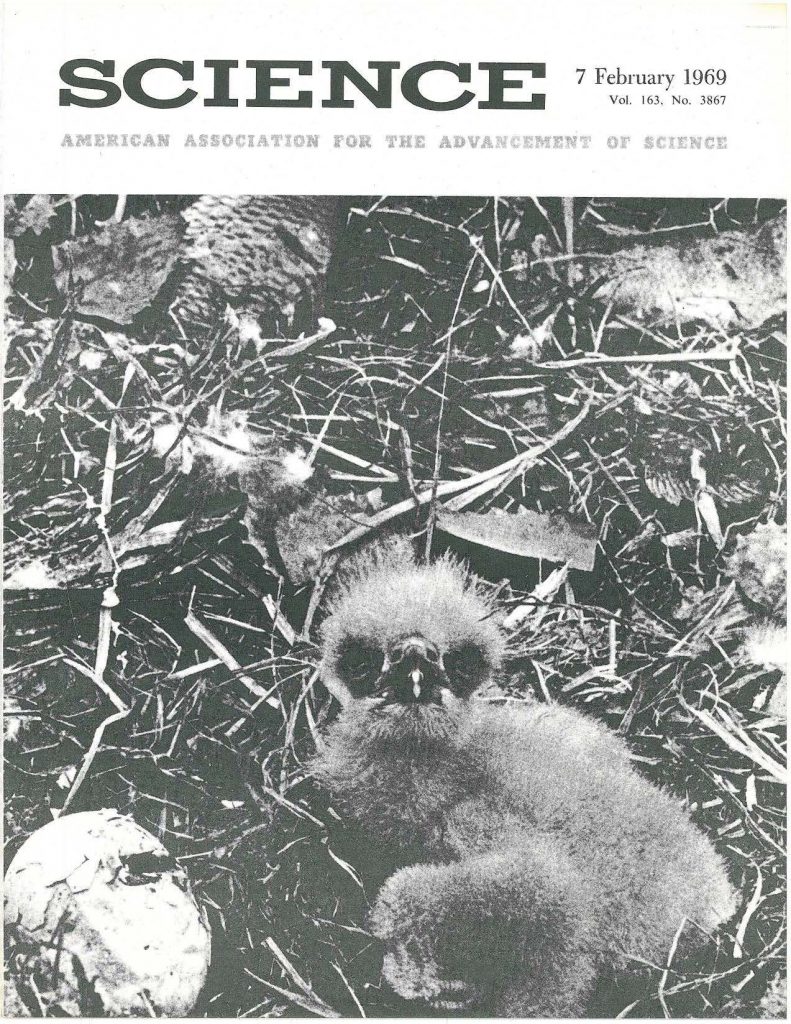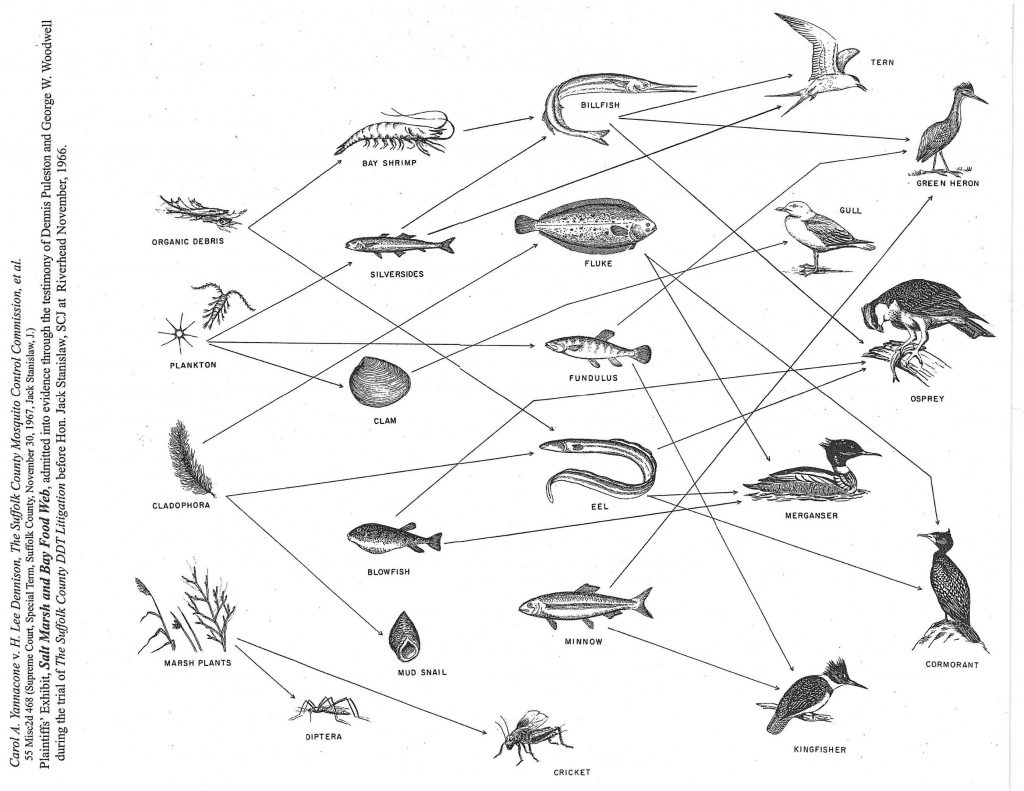- Introducing the Witness
- Analyzing DDT: some history
- Finally noticing PCBs
- PCBs interfere with DDT
- Telling only certain scientists about PCBs
- Thin Layer confirmation
- Sampling salmon
- Choosing columns
- Validating Robert Risebrough
- Lost among the peaks
- One more chromatogram
- Hydrolysis was the Industry secret
- The final examination
The Case of the Contaminated Coho
Where did all the DDT go?
The two principle issues of the DDT litigation were whether DDT was really a ubiquitous environmental contaminant and whether DDT was actually toxic at the low levels it was found throughout the environment.
At the time of the Yannacone DDT litigation in Suffolk County, detection levels of DDT in the environment were on the order of 1 to 10 parts per million. To visualize one ppm consider putting four drops of ink in a 55-gallon barrel of water and mixing it thoroughly.This procedure would produce an ink concentration of 1 ppm. Other ways to visualize a part per million are one inch in a little under 16 miles, one second in a little over 11.5 days; or one minute in a little under two years. One part per billion is approximately one drop of ink in a 5,000 gallon tanker truck of liquid.
Between the close of the DDT litigation in Suffolk County and the start of the trial of DDT in Madison, a revolution in analytical chemistry was taking place. Gas Liquid Chromatography (GLC) was coming on line in laboratories throughout the world and scientists were beginning to evaluation environmental samples once considered too small to measure. The changing of the guard occurred at Madison during the direct and cross-examination of Francis B. Coon, Director of Chemistry of the WARF Institute one of the premier citadels of analytical chemistry in the World. On that morning, Willard Stafford, one of the best known and highly respected trial lawyers in the Midwest, presented his surprise witness, Mr. Coon, hinting to the media assembled in the Jury Box that the case was over because Mr. Coon had analyzed a Coho salmon from Lake Michigan and found very little DDT residue.
There had been no advance notice of this evidence or advance notice that this witness was going to testify. An example of why in 1969 litigation was often referred to as, “Trial by Ambush.” Presenting Mr. Coon as a surprise witness was considered acceptable practice in those days, however, as the afternoon wore on the future of environmental analytical chemistry changed forever and a venerable instiution saw its reputation tarnished.
Introducing the witness
[docxpresso file=”https://yannalaw.com/wp-content/uploads/DDT/Coon_direct_1_Introduction.odt” comments=”true” SVG=”true”]
The history of DDT analysis
[docxpresso file=”https://yannalaw.com/wp-content/uploads/DDT/Coon_direct_1a_history.odt” comments=”true” SVG=”true”]
Finally noticing PCBs
It appears that there were other toxic substances contaminating the environment throughout the world and being accumulated by plants and animals including human beings just like DDT was.
[docxpresso file=”https://yannalaw.com/wp-content/uploads/DDT/Coon_direct_2a.odt” comments=”true” SVG=”true”]
PCBs interfere with DDT analysis
The Bear Creek Coho
[docxpresso file=”https://yannalaw.com/wp-content/uploads/DDT/Coon_direct_2b_BearCreek.odt” comments=”true” SVG=”true”] At the conclusion of his direct examination Attorney Stafford believed he had established that estimates of DDT in the environment were overestimated as a result of PCB contamination of samples and erroneous measurements with the new Gas-Liquid Chromatography technology coming on line. As was soon established during the remainder of the afternoon, he was wishful thinking and underestimated the way his adversary would attack the “surprise” testimony.The spectre of the eagle chick, its unhatched nestmate with the cracked “thin” eggshell, and the carcass of the Coho salmon was ever present during the cross-examination of Francis B. Coon.

Eaglet and an egg (which never hatched) were photographed in April 1965 in a nest on the Muskegon River in Michigan. The chipped, flaked condition of the egg is ascribed to a calcium deficiency attributable to residues of DDT or its metabolites in the parent. University of Wisconsin wildlife ecologist Joseph J. Hickey, calls DDT a “chemical of extinction.” See page 548, Science 7 February 1969.

Carmen’s River salt marsh and Great South Bay food web
Who was being told about PCBs?
[docxpresso file=”https://yannalaw.com/wp-content/uploads/DDT/Coon_cross_3_notice.odt” comments=”true” SVG=”true”] At the time of the Madison hearings four scientists were raising the alarm about the worldwide contamination of the Evironment withh DDT and its principle environmental metabolite, DDE. Ornithologist and raptor expert Dr. Joseph Hickey at the University of Wisconsin; chemist Dr. Charles Wurster at the State University of Stony Brook; biochemist Dr. Robert Risebrough of the University of California at Berkely; and wildlife biologist Dr. Lucille Stickel of the United States Fish & Wildlife Service in Pawtuxet, Maryland who has just begun to bring peregrine falcons from the brink of extinctin by hatching and rearing them initially in an environment relatively free of organochlorine pesticides.
Thin layer confirmation
[docxpresso file=”https://yannalaw.com/wp-content/uploads/DDT/Coon_Cross_3aTLConfirmation.odt” comments=”true” SVG=”true”]
Sampling salmon
[docxpresso file=”https://yannalaw.com/wp-content/uploads/DDT/Coon_Cross_4_CohoAgain.odt” comments=”true” SVG=”true”]
A question of columns
[docxpresso file=”https://yannalaw.com/wp-content/uploads/DDT/Coon_Cross_5_columns-1.odt” comments=”true” SVG=”true”]
Validating Robert Risebrough
[docxpresso file=”https://yannalaw.com/wp-content/uploads/DDT/Coon_Cross_5a_validatingBob.odt” comments=”true” SVG=”true”]
Lost among the peaks
[docxpresso file=”https://yannalaw.com/wp-content/uploads/DDT/Coon_Cross_5b_Peaks-2.odt” comments=”true” SVG=”true”]The attack on Mr. Coon’s analyses of the Bear Creek Coho at WARF targeted the additional chromatograms which were not provided in analyses done by Mr. Coon and WARF for Dr. Wurster, Dr. Risebrough, Dr. Hickey and Dr. Stickel. A curious and telling omission.
Lost among the peaks
[docxpresso file=”https://yannalaw.com/wp-content/uploads/DDT/Coon_Cross_6_the-additional-graphs.odt” comments=”true” SVG=”true”]
Hydrolysis was the industry secret
[docxpresso file=”https://yannalaw.com/wp-content/uploads/DDT/Coon_cross_6a_hydrolysis.odt” comments=”true” SVG=”true”]
The final exam
[docxpresso file=”https://yannalaw.com/wp-content/uploads/DDT/Coon_Cross7_testing.odt” comments=”true” SVG=”true”]And thus ended the career of Francis B. Coon, Director of Chemistry at WARF.
